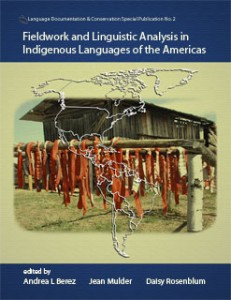
University of Hawai‘i Press
ISBN 978-0-8248-3530-9 (2010)
Fieldwork and Linguistic Analysis in Indigenous Languages of the Americas
LD&C Special Publication No. 2
Edited by Andrea L. Berez, Jean Mulder, and Daisy Rosenblum
Cover image
Front matter
Table of contents
Contributors
Acknowledgments
Foreword
Marianne Mithun, pp. iii-iv
Chapter 1. Introduction: The Boasian tradition and contemporary practice in linguistic fieldwork in the Americas
Daisy Rosenblum and Andrea L. Berez, pp. 1–8
Chapter 2. Sociopragmatic influences on the development and use of the discourse marker vet in Ixil Maya
Jule Gómez de García, Melissa Axelrod, and María Luz García, pp. 9–31
In this paper we explore the functions of the particle vet in Ixil Mayan and argue that it is a discourse marker used to perform both structural and pragmatic functions. Vet serves as a structural marker indicating temporally or causally interdependent items; it also has sociopragmatic functions, allowing speakers to present an evaluation of a discourse that invites interlocutors to also take a stance both on the information presented and on their roles in particular sociocultural activities. These functions of managing negotiations among interlocutors range from agreements on descriptive terms to calls for social action among entire groups, in all cases highlighting the social nature both of discourse and of group activity. The overlapping of the structural and pragmatic functions of vet demonstrates the grammaticalization cline ranging from adverb to discourse marker proposed by Traugott (1997). Our examination of vet in a range of genres produced by the Mujeres por la Paz of Nebaj, El Quiché, Guatemala, a cooperative formed in 1997 by Ixil Maya women who were widowed or left fatherless during the Guatemalan civil war, suggest that the effects of the individual and group identities and motivations of participants outweighs anticipated genre effects.
Chapter 3. Classifying clitics in Sm’algyax: Approaching theory from the field
Jean Mulder and Holly Sellers, pp. 33–56
Sm’algyax (British Columbia and Alaska) is a highly ergative VAO/VS language with an uncommonly wide range of clitics. This chapter has the two-fold function of demonstrating how Anderson’s (2005) constraint-based analysis of clitics gives insight into the complex behavior of Sm’algyax clitics, and how the clitics themselves afford empirical means of testing such a theory. The Sm’algyax data are drawn from both field research and published texts, reflecting a community-based approach to language documentation that has evolved through a long-term, collaborative relationship with the Tsimshian (Sm’algyax) communities. Building on Stebbin’s (2003) definitions of intermediate word classes in Sm’algyax and Anderson’s Optimality Theoretical approach, we determine that in terms of their varying phonological dependence, Sm’algyax clitics include internal, phonological word, and affixal clitics. The existence of affixal clitics in Sm’algyax, however, calls into question the viability of the Strict Layer Hypothesis (Selkirk 1984) as inviolable rules when describing clitics. Furthermore, Sm’algyax provides strong evidence that the direction of clitic attachment is more clitic specific than language specific. In characterising the behaviour of Sm’algyax clitics, we find that not only does linguistic theory help sharpen our understanding of the fieldwork data, but also that field linguistics has consequences for linguistic theory.
Chapter 4. Noun class and number in Kiowa-Tanoan: Comparative-historical research and respecting speakers’ rights in fieldwork
Logan Sutton, pp. 57–89
The Kiowa-Tanoan family is known to linguists by two characteristic features: (a) a package of complex morphosyntactic structures that includes a typologically marked noun class and number marking system and (b) the paucity of information available on the Tanoan languages due to cultural ideologies of secrecy. This paper explores both of these issues. It attempts to reconstruct the historical noun class-number system based on the diverging, yet obviously related, morphosemantic patterns found in each of the modern languages, a study that would be greatly benefited by fieldwork and the input of native speakers. At the same time, it reviews the language situation among the Kiowa-Tanoan-speaking communities and what some of the difficulties are in doing this kind of fieldwork in the Pueblo Southwest, touching on the myriad complex issues involving the control of information and the speech communities’ rights over their own languages as well as the outside linguist’s role in such a situation. The paper underscores these points by using only language data examples from previous field research that are already available to the public so as not to compromise native speakers’ sensitivity to new research on their languages.
Chapter 5. The story of *ô in the Cariban family
Spike Gildea, B.J. Hoff, and Sérgio Meira, pp. 91–123
This paper argues for the reconstruction of an unrounded mid central/back vowel *ô to Proto-Cariban. Recent comparative studies of the Cariban family encounter a consistent correspondence of ə : o : ɨ : e, tentatively reconstructed as *o2 (considering only pronouns; Meira 2002) and *ô (considering only seven languages; Meira & Franchetto 2005). The first empirical contribution of this paper is to expand the comparative database to twenty-one modern and two extinct Cariban languages, where the robustness of the correspondence is confirmed. In ten languages, *ô merges with another vowel, either *o or *ɨ. The second empirical contribution of this paper is to more closely analyze one apparent case of attested change from *ô > o, as seen in cognate forms from Island Carib and dialectal variation in Kari’nja (Carib of Surinam). Kari’nja words borrowed into Island Carib/Garífuna show a split between rounded and unrounded back vowels: rounded back vowels are reflexes of *o and *u, unrounded back vowels reflexes of *ô and *ɨ. Our analysis of Island Carib phonology was originally developed by Douglas Taylor in the 1960s, supplemented with unpublished Garifuna data collected by Taylor in the 1950s.
Chapter 6. Multiple functions, multiple techniques: The role of methodology in a study of Zapotec determiners
Donna Fenton, pp. 125–145
Field linguists use a combination of techniques to compile a grammatical description, starting with various types of targeted elicitation and followed by the study of more natural speech in the form of recorded texts. These usual techniques were employed in my work on Teotitlán del Valle Zapotec, an Oto-Manguean language spoken in Mexico, but in an unusual order, with texts, mainly folk tales and life histories told by community elders, being collected and analyzed first due to the priorities of the documentation project I was a part of. This paper examines the role that methodology played in the investigation into one small area of the grammar, a set of noun phrase-final determiner clitics. These clitics make both spatial and temporal distinctions, raising theoretical questions regarding the role of a temporal marker in the NP. At the same time, it brought to light some interesting issues surrounding methodology in fieldwork: how does the method of collection affect the type of data gathered, and does the order in which different methodologies are employed affect the final outcome?
Chapter 7. Middles and reflexives in Yucatec Maya: Trusting speaker intuition
Israel Martínez Corripio and Ricardo Maldonado, pp. 147–171
In this paper we provide a characterization of the middle construction in YM, and show that the apparently unpredictable distribution of middle voice in YM corresponds to a neatly identified, and quite limited, system of absolute events, i.e., events in which no energy is expended (Langacker 1987). This strategy is not exploited by other related Mayan languages, which tend to encode all absolute events as simple intransitive verbs. The semantic coherence of middle voice in YM is only discernible by combining analysis of narrative texts and direct elicitation with attention to speaker intuition in a variety of situational contrastive contexts guided by cognitive principles which are known to determine the behavior of middle voice systems in other languages.
Chapter 8. Studying Dena’ina discourse markers: Evidence from elicitation and narrative
Olga Charlotte Lovick, pp. 173–202
This paper is concerned with discourse markers in Dena’ina Athabascan. One problem for transcribers and translators of Dena’ina texts is the great number of particles (i.e., words that cannot be inflected) that, according to speaker judgments “have no meaning” or “mean something else in every sentence.” This suggests that these particles are discourse markers, whose function is to relate discourse units to each other and to the discourse as a whole. The paper contrasts two different forms of linguistic inquiry: direct inquiry in the field, by elicitation of meaning and function of the discourse markers, and indirect inquiry, by study of a corpus of Dena’ina narratives. While elicitation is helpful in obtaining an initial gloss for the discourse markers, it is shown that only the study of texts will give us insight into the function of such particles and allows us to understand the important differences between particles that, on first sight, appear to be synonymous.
Chapter 9. Be careful what you throw out: Gemination and tonal feet in Weledeh Dogrib
Alessandro Jaker, pp. 203–222
The Weledeh dialect of Dogrib (Tłįchǫ Yatiì) is spoken by people of the Yellowknives Dene First Nation, in and around Yellowknife, Northwest Territories. Within the formal framework of Lexical Phonology (Kiparsky 1982), this paper argues for an over-arching generalization in the phonology of Weledeh Dogrib: the constraint NoContour-Ft, which prefers (High-High) and (Low-Low) feet, but militates against (High-Low) and (Low-High) feet. NoContour-Ft is satisfied differently in different morphophonological domains: vowel deletion at the Stem Level, gemination at the Word Level, and High to Mid tone lowering at the Postlexical Level. This analysis requires that consonant length be treated as phonological in Dogrib—that is, consonant length contributes to syllable weight and mora count—even though there are no minimal pairs based on consonant length. Similarly, the distinction between High and Middle tone does not distinguish any lexical items, but is nevertheless important for the prosody of the language. Thus the paper makes a methodological point about the importance of allophonic alternations for phonological theory. Our view of what counts as contrastive or allophonic, however, is to a large extent theory-dependent; therefore, the paper also emphasizes the importance of phonetic measurements when doing fieldwork.
Chapter 10. Revisiting the source: Dependent verbs in Sierra Popoluca (Mixe-Zoquean)
Lynda Boudreault, pp. 223–261
Sierra Popoluca (SP) is a Mixe-Zoquean language, spoken by about 28,000 individuals in southern Veracruz, Mexico. The objectives of this paper are (1) to explore the structures of dependent verb constructions in SP and the contexts in which they occur and (2) to highlight the stages in which data is gathered and the interplay between text collection, elicitation, and analysis. SP is an ergative, polysynthetic, head-marking language. It has five dependent verb construction types. Early analyses suggested that dependent verbs were non-finite, nominalized forms. Further research indicated that the verbs are components in complex predicates that share inflection for aspect/mood, person, and number. Implicated in the analysis of these constructions are: the prosodic system; the alignment system, which is hierarchically driven with split ergativity; and the number system, also hierarchically driven. The teasing apart of the various grammatical features led to a multi-step process of analyzing and collecting data. By looking at a complex grammatical structure, this paper highlights the interdependency of corpus building, text analysis, and elicitation and the strategies used to negotiate between naturally occurring speech, in which data may be obscured by phonology, and elicited data, which frequently produces periphrastic constructions or alternative utterance types.




